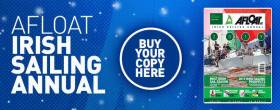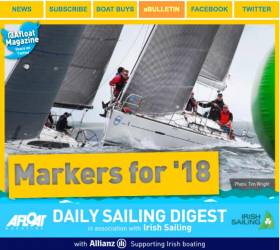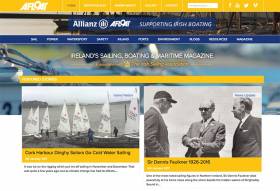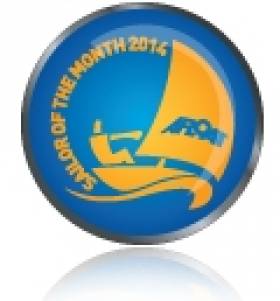Displaying items by tag: Afloatie
Afloat.ie Says 'Thank You' to Our 1.3m Readers & Supporters
Dear Reader,
At the end of another busy year at Afloat.ie in 2018, we want to express our thanks for your continued support.
Because of the generous backing from you and our other supporters, Afloat.ie is looking at another record year for visitors, with a significant increase on 2017 figures.
Our website dedicated to Irish sailing, boating and maritime issues reached a high water mark a year ago, informing and entertaining a larger boating audience than ever before, and is now set to repeat that as we head into 2019.
The latest statistics show unique visitors to the site are heading for 1.3 million — a phenomenal number in what remains a challenging climate for online media.
Afloat’s popular online format has a strong returning readership, with half of daily visits being repeat readers, and with strong social media engagement.
Based on site analytics, 70% of our traffic is from Ireland, with a good geographic spread across the Irish Sea and into the west coast of Britain.
Most encouragingly, nearly two-thirds (65+%) of Afloat.ie traffic now comes from mobile devices — an important return on investment in the mobile site by our journalist and developer team.
What’s more, our website’s bounce rate (the percentage of visitors to a particular website who navigate away from the site after viewing only one page) of 21% is well below the industry average of 40% to 60%, according to HubSpot.
Together, those numbers make a strong argument for Afloat.ie growing as a go-to resource for an engaged audience with sailing, boating and marine interests.
Our high authority in the boating market is reflected, too, in Google and other search engines’ quick indexing of our stories, giving them valuable reach beyond our core readership.
All of this is a testament not only to our tight-knit and active community of readers, but also Afloat.ie’s combination of opinion, hard news and features which puts it at the very heart of the national — and increasingly international — conversation on sailing, boating and maritime affairs.
The site’s readership has climbed consistently year on year since 2008. Last year marked the first time reader numbers broke the one million barrier, and now that figure is climbing even higher.
It’s proof positive that our mission — to provide Irish sailing and boating clubs, classes and the wider maritime community with a comprehensive, reliable and independent platform promoting our great sport to the wide and connected audience only the internet provides — is truly working.
This success, as we’ve said before, would not be possible without our full–time marine journalists and web developers, and indeed our advertisers and supporters who are dedicated to promoting Irish sailing and boating. Progress, like we have achieved to date, would not have been achievable without it.
As previously acknowledged, it remains a challenging climate for online media, particularly when it comes to monetisation.
Thanks to your support, however, we have not resorted to putting our content behind a paywall like other news websites — because we want to keep our marine journalism open to the widest possible audience, which we believe is one of the keys to our growth. The figures bear this out.
Your contribution directly influences our quality marine journalism, and the time, money and effort it requires, both in print and online, and for that we cannot thank you enough.
All of us at Afloat wish you the best for Christmas and 2019, and hope you will continue your valued support in the new year to come.
Round–the–World Sailor Pete Hogan Goes Virtual Sailing
How many times have you heard it said ‘Sailing is not a spectator sport’. Well, it is now, says Round–the-World Sailor Pete Hogan, all thanks to the internet. Below, Hogan, who built a 30' gaff rigged ketch, called Molly B, and sailed her around the world by way of Cape Horn, lists some of his favourite hangouts but warns if you are one of those people who daily buy your copy of the Times at the local newsagent, this little piece is probably not for you...
I seem to have become a virtual sailor. I spend hours gazing at a computer screen. I am transported to the Southern Ocean, the Solent, Coral Grove, or Long Island Sound. I am there on board the foiling Cats as they compete for the Americas Cup. I cavort with scantily clad Australians as they anchor in remote tropical lagoons all over the Pacific. I have traversed the NW passage several times. I have competed in the Volvo Ocean race, along with 300,000 others. All from the comfort of my own living room. And all largely for free.
How many times have you heard it said ‘Sailing is not a spectator sport’. Well, it is now. The watershed moment must surely have been the wonderful presentation of the 34th Americas Cup 2013, in San Francisco. Whatever cruising die-hards might think of the strange foiling craft, the on board cameras, the computer graphics, the instant editing, the expert presenters, analysis and interviews all combined to make sailing in this historic event more than real. I did not sleep for the entire competition.
These are some of my favourite hangouts.
Afloat.ie
Starting at home. Why would anyone buy a yachting magazine any more? Here it is, all for free, Covering a wide range of maritime matters of interest to Irish readers, much more, sooner and in greater depth than can be contained in the hard copy. It is worth logging into every day as it updates constantly. It is always ready and happy to host news of your event or adventure. Presently free, with a pop up plea for voluntary subscriptions, I would urge sailors to subscribe to Afloat to keep this important resource going. There are of course many other yottin mags online, some free and some with paywalls. But Afloat is Ireland's Own.
Wavetrain
There are many blogs by sailors. I even tried to do one myself for a while but one runs out of wind. This is a very professional blog by one Charlie Doane who is the cruising editor for Sail magazine and a keen cruiser in his own right. It has a super archive section covering many cruising topics, personalities and controversies. That such blogs exist is an indication of the difficulties which sailing mags and all hard copy media are facing today.
I’m 'friends' with John Bertrand, Julian Everitt, Prof Maurice O Connell, Damian Foxall, Lin Pardey, among many other famous and just plain ordinary sailors on Facebook. I know where they are what they are doing and can contact them. Also I can contact in the same way 147 of my fellow ICC members (out of a possible 550 or so) who are part of the ICC Facebook group. How amazing is that? In fact a little fission broke out in the FB group recently when somebody commented that members should not be posting updates of their cruising adventures. A lively debate ensued….
For die hard virtual sailors, sailonline is a separate Facebook group which runs virtual races.
Scuttlebutt
Good, established, mainstream sailing news website.
Sailing Anarchy
Based in San Diego this is the bad boy of writing about sailing. While a lot of it is racing oriented it also carries content about cruising matters, designers, builders and equipment. Can be amusing though they use the f word and other Americanisms a bit. Their forums frequently feature wonderful anecdote from long forgotten celebrities and events from the classic days of offshore sailing. Google, Wikipedia, Youtube. The gateway to almost unlimited information, resources, opinions and advice about sailing - locations, personalities, vessels and equipment.
Apollo Duck
Hours of idle window shopping. Also includes countless boats for sale worldwide.
Irish Sailing Annual – Buy Your Copy Here!
This 64 page full colour A4 magazine includes a review of 20187 plus all the details for 2019 Afloat and all your latest sailing news in time for Christmas! BUY IT HERE!
Order your copy at €8 plus €3.10 shipping fee in Ireland and UK – click HERE to order.
We'll post all orders received daily up til December 23rd! for Christmas delivery!
In newsagents from Thursday, December 13th or buy your copy HERE!
Afloat.ie Says 'Thank You' to Our 1.2m Readers
Afloat.ie is on course for another record year for visitors on its dedicated Irish boating website, with a 20% increase on 2016 figures.
The Irish sailing, boating and maritime website reached a high water mark a year ago, informing and entertaining a larger boating audience than ever before — and is now set to repeat that in 2017, too.
The latest statistics show unique visitors to the site are heading for 1.2 million.
Afloat’s popular online format has a strong returning readership, with half of daily visits being repeat readers.
Based on site analytics, 70% of traffic is from Ireland, with a good geographic spread across the Irish Sea and into the West Coast of Britain.
Nearly two-thirds (65+%) of Afloat.ie traffic is from mobile devices — an important return on investment in the mobile site by our journalist and developer team.
What’s more, the bounce rate (the percentage of visitors to a particular website who navigate away from the site after viewing only one page) of 21% is well below the industry average of 40% to 60%, according to HubSpot.
And Afloat.ie’s high authority in the boating market means stories are indexed quickly by Google and other search engines, giving stories valuable reach.
It’s a testament not only to our tight community of readers, but also Afloat.ie’s combination of opinion, hard news and features which puts it at the very heart of the national conversation on sailing, boating and maritime affairs.
The site’s readership has climbed consistently year on year since 2008. Last year marked the first time reader numbers broke the one million barrier, and now that figure is climbing even higher.
It shows that our mission to provide Irish sailing and boating clubs, classes and the wider maritime community with a comprehensive and reliable and independent platform, promoting our great sport to the wide audience only the internet provides, is truly working.
As we said earlier this year, this success would not be possible without our full–time marine journalists, our advertisers, supporters and web developers who are dedicated to promoting Irish sailing and boating.
Once again we express our many thanks to all our readers and advertisers for your continued interest in Afloat.ie.
Thank You To All Our (One Million) Readers in 2016
Afloat.ie, the Irish sailing, boating and maritime website, has reached another high water mark in 2016 informing and entertaining a larger boating audience than ever before.
Based on site analytics, Afloat.ie readership was up 30 per cent on 2015 with more than one million unique visitors and over two million page views to the dedicated Irish boating magazine website.
The just released figure of 1,003,232 unique readers is for the calendar year 2016. Afloat.ie readership has climbed consistently year on year since 2008 but 2016 is the first year it broke the one million barrier.
Afloat's popular online format has a strong returning readership with around 48% of daily visits being return visitors. In fact, over the peak sailing months in 2016 Afloat surpassed its own records for unique (direct) visitors with an average of 80,000 unique daily visitors per month.
Afloat.ie has been working hard to achieve top Google Search rankings and together with a tightly bound community of readers, Afloat.ie's combination of opinion, hard news and features puts it at the very heart of the national conversation on sailing, boating and maritime affairs.
It's a satisfying result to date because the aim has always been to provide Irish sailing and boating clubs, classes and the wider maritime community with comprehensive and reliable information in a dynamic independent site to promote our great sport to the wide audience only the internet provides.
Success this far would not have been possible without our full–time marine journalists, our advertisers, supporters and web developers who are dedicated to promoting Irish sailing and boating.
With many thanks to all our readers and advertisers for your continued interest in Afloat.ie.
You can support the work of Afloat by donating here.
The Afloat team
#SailorOfTheYear – Liam Shanahan has been named Afloat.ie Irish Sailor of the Year for 2015.
The Irish Sea yachtsman and June's Sailor of the Month was presented his award by Sport Ireland chief executive John Treacy at the Irish Sailing Awards gala in Dublin's Royal College of Surgeons this afternoon (Thursday 4 February).
Liam Shanahan wins overall 2015 Sailor of the Year https://t.co/MDaTjreQZG pic.twitter.com/Mnz6aEy9qK
— Irish Times Sport (@IrishTimesSport) February 5, 2016
Shanahan was recognised for his comprehensive victory in the 280-mile Dun Laoghaire to Dingle Race at the helm of Ruth, his family's J/109, marking the highlight of a busy June in Irish sailing.
Not one to rest on his laurels, Shanahan – and his dependable crew, especially so since they're family – would go on to retain the James Eadie Trophy in the ISORA Offshore Championship, fending off the strong challenge of Andrew Hall's J/125 Jackknife and Peter Dunlop and Vicky Cox's J/109 Mojito in the season's final race from Pwllheli to Dun Laoghaire in September.
And what's more, Shanahan was the clear choice of both the judging panel and Afloat.ie readers alike from the field of 17 individual and joint nominees, garnering 1,359 votes out of nearly 6,500 cast.
In accepting his prize, Shanahan said it was "an award for Corinthian and family sailing", which he regards as the heart and future of the Irish sailing scene.
Hosted by entrepreneur Bobby Kerr along with Afloat.ie's WM Nixon and Irish Sailing Association (ISA) president David Lovegrove, the Irish Sailing Awards also recognised the ISA Youth Sailor of the Year and Training Centre of the Year, as well as the Mitsubishi Motors Club of the Year.
Guests at the event included members of the ISA's Olympic and youth sailing squads, national senior and youth champions, class captains and club commodores, and a number of past Sailor of the Year awardees, such as 2012's winner George Kenefick.
2015 Afloat Irish Sailor of the Year winner Liam Shanahan at the Irish Sailing Awards today: Dublin @AfloatMagazine pic.twitter.com/sExNo1b4uy
— Irish Sailing (@Irish_Sailing) February 4, 2016
Sailing Towards Better Communications in the Digital World
The Afloat.ie website, which is ranked by Google as Ireland’s leading source for the provision of a broad range of recreational and commercial maritime information, news and comment, has been completely updated in recent weeks. Yet though it has acquired a fresh, fast-moving look, and now provides a new and unrivalled multi-platform service, the change has been effected without any interruption to service. That said, our alert and more tech-savvy readers have been welcoming each addition to our service as it comes online. The new-style Afloat.ie is both a ground-breaking development for maritime communications and news exchange and analysis in Ireland, and yet it is also a healthy continuation of an integral part of our maritime life which stretches back more than fifty years. W M Nixon takes up the tale, and looks forward to where this remarkable story might lead us all.
In the early 1960s the Irish Dinghy Racing Association (founded 1946) was in the process of being re-born as the Irish Yachting Association. A competitive three-boat Irish campaign had been mounted for the 1960 Rome Olympics with the sailing events in Naples, and the confidence gained from this project gave the nascent national authority new energy and clearer direction.
The proposed wider remit for the new IYA aimed to make the Association of interest to all sailing and boating enthusiasts, and a sub-committee - drawn from all the main sailing centres through the yacht and sailing clubs which were the core of the national authority - was set up to explore ways of establishing an Irish sailing and boating magazine to reach the small but growing home market.
The intention was that the IYA should publish the magazine itself, as it was not initially a valid stand-alone commercial proposition. The first Irish Yachting was the July/August edition of 1962, and it continued as a bi-monthly publication through the 1960s, relying for content largely on modestly-paid contributors – both specialist and regional - and the editorial and production work co-ordinated by IYA Secretary Ursula Maguire, with the Association underwriting the cost of a magazine whose income was augmented by advertising.

Clayton Love Jnr of Cork. Working closely with the late Jimmy Mooney of Dun Laoghaire, as President of the Irish Dinghy Racing Association he transformed it into the Irish Yachting Association, and together they co-ordinated the introduction of Irish Yachting magazine in 1962. In 1968 he was one of the small committee which oversaw the conversion of Erskine & Molly Childers’ famous Asgard to become Ireland’s first sail training vessel, and at the same time he was negotiating the amalgamation of the Royal Munster Yacht Club with the Royal Cork Yacht Club to have the Royal Cork YC thriving for its Quarter Millennium Celebration in1969-1970. A noted IDRA 14 and Int. 505 sailor, he won the Helsmans Championship, and in this photo, he is wearing the original IYA tie.
The hope had always been that the interest in sailing and boating in Ireland, with a developing marine industry to support it, would increase to such an extent that the magazine would become of interest to a commercial publisher, as it was felt that an in-house publication from a National Authority lacked the bite and broader interest to compete properly with the British yachting magazines which circulated widely in Ireland north and south.
In 1970 this aim was achieved, with the rights taken over by a commercial periodical publishing group which agreed that Irish Yachting & Motorboating – as it soon became – would be a monthly magazine which would guarantee space for specifically IYA news and policies, yet would equally expect to publish contrary views and incisive analyses.
Historic highlight. David Wilkins and Jamie Wilkinson win the Silver medal for Ireland in the Flying Dutchman Class at the 1980 Olympics
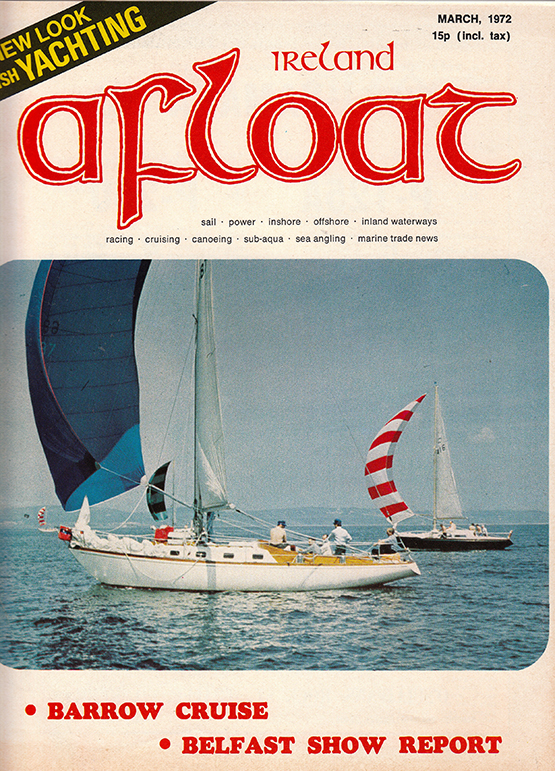
New look Irish Yachting: Afloat's first edition in 1972. Today's magazine and website covers the same Irish maritime topics as it did 43 years ago
At the same time it would make added efforts to reach potential newcomers in every area of boating, and general readers in all other areas of maritime interest. As a result of this, the magazine’s name was then changed to Afloat, and through the 1980s and the 1990s, with occasional changes of publishers, the magazine played a central role in the development and growth of Irish sailing and boating.

Going global. The Feb/March 1992 edition of Afloat celebrated Ireland’s win in both the December 1991 Southern Cross series, and the overall win in the Sydney-Hobart race 1991, with John Storey’s all-conquering Atara as our cover girl...
Since then, as our regular readers will be aware, over the past 20 years Afloat has been on a firm commercial footing and has developed into the comprehensive publication and Internet forum it is today. It continued to be so through the difficult times of recession, and through radical changes both in the Irish marine industry – the main supporters of the published version of Afloat Magazine – and the ways in which those marine manufacturers and traders reach their potential markets.

Another big international win, this time in the 21st century. Ger O’Rourke’s Cookson 50 Chieftain from Kilrush in the early stages of the Rolex Fastnet Race 2007, which she won overall. The Limerick skipper deservedly became Afloat.ie “Sailor of the Year” on the strength of this great achievement. Photo: James Boyd
Consolidation of the global marine industry, combined with the fact that Ireland is now within a very few hours flying time from the main centres of marine manufacturing, have meant that Ireland has become, in effect, a province of the European boat business.
Equally, the growth of the Internet has been such that international marine corporations have been able to develop websites of such quality that they by-pass established means of reaching potential customers. In the final analysis, these website constitute advertising. But they have now reached such a standard of sophistication that the uninformed reader sometimes has difficulty in differentiating a subtle sales pitch from genuine news and comment.
This re-direction of marketing budgets has inevitably impinged on established methods of communication and public conversation in the maritime sphere as elsewhere. But open media outlets such as Afloat.ie have in turn been re-inventing themselves in order to continue to provide their best possible service in an increasingly challenging environment.
In fact, Afloat magazine was one of the first to embrace new technology in the Internet age, with our initial website launched in 1993 with support from Allianz Insurance as Founding Sponsor. Now, some 53 years after Afloat first published on paper, it is the leader in Irish maritime communications online, while at the same time continuing to publish a quarterly version of the magazine on paper, with the Afloat Autumn 2015 edition hitting the news-stands next week.
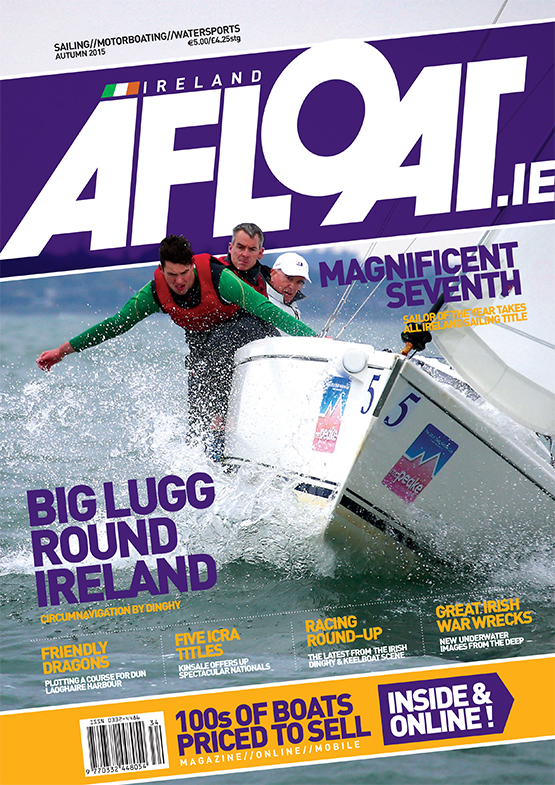
Quarterly form – the up-coming Autumn 2015 Afloat, on sale next week
Today's scenario on the Internet is such that:
Afloat.ie's popular online format has a strong returning readership with around 48% of daily visits being return visitors. In fact over the peak sailing months in 2014 Afloat surpassed its own records for unique (direct) visitors with an average of 52,024 visitors a month, and as this graph shows, our key figures in 2015 are up 12%, with a significant further underlying rise towards the latter part of the season, though nothing quite matches the spike when Musandam Oman was establishing a new Round Ireland Record back in the Spring.

Afloat.ie's improving performance through 2015, with a spike for the successful Round Ireland record bid by Musandam Oman
The team works hard to achieve top Google Search rankings, and together with a tightly bound community of readers, Afloat.ie's continually up-dated combination of opinion, hard news and features puts it at the very heart of the national conversation on sailing, boating and maritime affairs.
It's a satisfying result to date because the aim has always been to provide Irish sailing clubs, classes and the wider maritime community with comprehensive and reliable information in a dynamic independent site to promote our sport to the wider audience which only the Internet provides.
This has been supported this year by the ISA with their renewal of a necessary relationship with Afloat.ie which in a sense marks a return to the situation in 1962. It’s probably a unique tie–up in world sailing, but is necessary because athough Ireland has all the status of a leading sailing nation, globally speaking we have a small national economy.
In addition, the internationalisation of the marine industry, and its increasing reliance on in-house digital communication for product publicity, means that the only significant income stream in Irish sailing and boating is through the clubs and the Sports Council grants which keep the ISA functioning.
The working agreement between the ISA and Afloat allows the association to use Afloat.ie’s sailing news feed and the use of Afloat's Sailor of the Year Award, and it is proving to be a successful link-up. It’s healthy in that Afloat.ie can provide a platform for much livelier discussions and topics than is the case with the ISA’s own website, which is obliged to be somewhat in the nature of a Government Gazette.
The Internet poses many problems, not least for traditional media, but in all my years as a sailing writer I have never seen the potential that exists for exciting Irish sailing communications as clearly as I do today with the current output from the Afloat website. It means that the spirit of the unique and lively Irish sailing and boating community is reflected by their means of communications with each other, and with the outside world.
The ISA has a valuable communications budget that needs to be spent very wisely to cover all areas of our sport, and to achieve this I would urge the ISA and Afloat to seek a stronger relationship. It would be a dynamic move which would help to provide additional communication services to sailing clubs throughout the country, while also reaching out to a wider market, and I am firmly of the opinion that it would fit well with the new direction that the reformed ISA is trying to take.

W M Nixon, seen here at last month’s Cruising Association of Ireland rally in Dublin, became Editor of Irish Yachting when it began commercial monthly publication in 1970. Photo: Aidan Coughlan
Success as Afloat.ie Hits 250,000 Users This Summer
Afloat.ie, the Irish sailing, boating and maritime website, has reached a high water mark this summer, informing and entertaining a larger boating audience than ever before.
Based on analytics, Afloat.ie readership was up ten per cent on the same period last year with more than 225,000 unique visitors and 629,216 page views to the dedicated Irish boating magazine website.
The Summer figures are for the period May 10 to August 10 2015.
Afloat's popular online format has a strong returning readership with around 48% of daily visits being return visitors. In fact, over the peak sailing months in 2015 so far Afloat surpassed its own records for unique (direct) visitors with an average of 52,024 unique visitors a month.
Afloat.ie has been working hard to achieve top Google Search rankings and together with a tightly bound community of readers, Afloat.ie's combination of opinion, hard news and features puts it at the very heart of the national conversation on sailing, boating and maritime affairs.
It's a satisfying result to date because the aim has always been to provide Irish sailing and boating clubs, classes and the wider maritime community with comprehensive and reliable information in a dynamic independent site to promote our great sport to the wide audience only the internet provides.
To this end, Afloat.ie has launched a new mobile responsive website over the weekend with a new boats for sale section and a community marketplace section along with a host of new site features.
Success this far would not have been possible without our full–time marine journalist, our advertisers, supporters and web developers who are dedicated to promoting Irish sailing and boating. We salute our sponsor Allianz, the Irish Sailing Association and the Irish Marine Federation for their commitment.
With many thanks to all our readers and advertisers for your continued interest in Afloat.ie
The Afloat team
#soy – The new stars of the Irish sailing firmament are Anthony O'Leary (57) of Cork and the successful Commodore's Cup team. In a gala ceremony in Dublin this afternoon to celebrate the many achievements of our sailors in 2014, O'Leary and his team mates were applauded as the crème de a crème, reflecting his own insistence throughout the exemplary Commodore's campaign that it was only by a close-knit group effort that success could be obtained.
The sharing of the award - presented in a crowded gathering of Ireland's diverse sailing community in the Royal College of Surgeons by Minister for the Marine Simon Coveney on behalf of the Irish Sailing Association and Afloat.ie - proved to be doubly appropriate, as O'Leary himself could not be present owing to a longterm commitment to a week-long sailing campaign currently under way in Florida.
However, his son Rob – a former Sailor of the Month himself - accepted the Afloat.ie Sailor of the Month award for June 2014 on his father's behalf. That award was to celebrate Anthony O'Leary's success in being the overall winner of the British Open IRC Championship.
But after that, his personal achievements continued at a high level throughout the season, as he became the Helmsmans Champion 2014 early in September racing with the J/80s in Howth, and then later that same month he won through to be the 1720 National Champion racing in Baltimore.
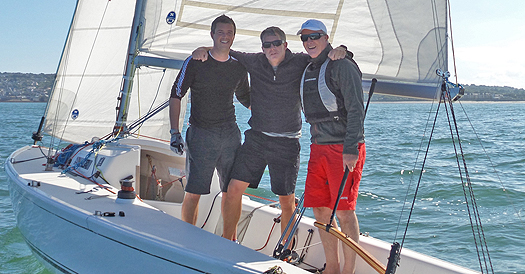
Anthony O'Leary (right) and his crew Dylan Gannon (left) and Dan O'Grady celebrate All Ireland victory off Howth in the Helmsmans Champs. Photo: Jonathan Wormald
That this all occurred within weeks of his brilliant leading of the Commodore's Cup team during the last week of July gives some indication of the enormous contribution made by Anthony O'Leary to Irish sailing during 2014.
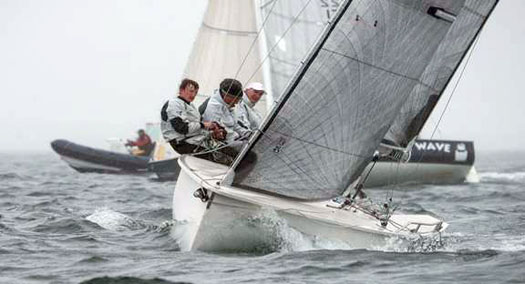
1720 National Champions – Anthony O'Leary's Antix crew in winning form again off Baltimore. Photo: Aedan Coffey
But as the Commodore's Cup win also saw the Afloat.ie International Award for July being made to the entire team, the Sailor of the Year 2014 was jointly presented to Rob O'Leary standing in for his father, and to Michael Boyd, recently elected Commodore of the Royal Ocean Racing Club, who was one of the Irish skippers in the superb Commodore's Cup team.
It is the second time the Crosshaven skipper has won the Irish Sailor of the Year title, he lifted it first in 2010.
About Us
Afloat Ireland's boating Magazine!
Afloat, in over 50 years of production, is a vibrant specialist magazine in print online which has continually adapted to the demands of its readership, with an industry insight which is quite simply unique. Edited by David O'Brien (50), a former European and World sailing champion and Olympic sailor from the 2000 Games, it is produced by a group of dedicated watersports enthusiasts and has become essential reading for all those who have more than a passing interest in the development of Irish watersports.
Afloat is the only publication dedicated to serving the needs of the sector, and it does so with a truly independent voice. Afloat's association with the industry's twin governing bodies the ISA and IMF allows it to offer an insider view, but the magazine maintains independent editorial control.
Packaged as a glossy magazine with an emphasis on colour photography, no other specialist magazine in Ireland offers such an impressive range of comment, information and advice in such an attractive format.
50 years on Irish waters a waterborne success
The most obvious indicator of Afloat's success lies in its increased sales, which have grown steadily to a current figure of 8,000, rising to over 10,000 for boat show editions.
Online, the Afloat.ie website recorded €1m unique visitors in 2016. This has been over the past eight years by building a tightly knit online community around Afloat.ie. We did this by achieving top Google Search rankings and also by having a great social media presence within our niche. Afloat.ie's combination of opinion, hard news and features puts it at the very heart of the national conversation on sailing, boating and maritime affairs.
We cover sailing and also other Irish watersports including rowing, canoeing, angling, kitesurfing, diving and waterskiing.
Reader comments are encouraged through our letters page, and through Afloat's unique tie-in with Seascapes, RTÉ Radio One's maritime current affairs programme. Seascapes presenter, Marcus Connaughton, contributes a regular column to the magazine, and devotes considerable space to the views of listeners who have contacted that programme's comment line.
Arm in arm with the IMF, Afloat submitted a plan to government in 1994 and again in 2004 detailing how and where future marina berths should be located around the coast. Seven years later, new coastal marinas are taking shape around the coast using the IMF/Afloat proposal as a template. The commitment by the Minister for the Marine, Frank Fahey, to invest £4.5 million in this marina network followed directly from this IMF/Afloat campaign, and the magazine is the only Irish publication to track and monitor the progress of this programme of expansion.
Afloat conducted a reader's poll in 1998 on the future of the State's first sail-training vessel, Asgard. The results of this poll which favoured restoring and refloating the 1914 gun-running vessel by a majority of 9 to 1 laid the foundations for the subsequent campaign by the Asgard Restoration Project, led by entrepreneur Harry Crosbie. Restoration work on the Asgard has now begun, and the government has committed to contributing half the estimated £800,000 cost of the project, which Afloat continues to monitor and support.
In association with the IMF, Afloat has also been at the forefront of efforts since 1985 to reduce VAT levels on Irish marine products to encourage growth across the industry. While this rate has been lowered from 35 per cent to 20 per cent over this period, the Irish marine industry still faces a competitive disadvantage in relation to the British rate of 17.5 per cent. Afloat is committed to continuing its involvement in this campaign until this rate difference disappears.
Reader profile
Produced by watersports enthusiasts, for watersports enthusiasts Afloat's reader focus doesn't read as easily as our magazine, but it lies at the core of our success.
Watersports differs from most other leisure activities in that it lacks a significant spectator class. Regardless of age or infirmity, if you're passionate about water, then you're probably going to be found on it.
Everyone at Afloat from the editor, through our contributors, to the production staff sails, cruises or surfs. In a very real sense then, Afloat is produced by and for those people whose lives on the water are interrupted by their work on land.
But this relatively simple focus hides a more complex agenda. The Irish watersports industry with some 70,000 participants is anything but homogenous. Moving from sailing and cruising to windsurfing and jetskiing, Afloat faces the challenge of providing a comprehensive monthly service to what is, in effect, a range of very different sports. A further indication of the sector's dynamism and complexity lies in the emergence of a growing band of professional sailors for whom watersports is, quite literally, a way of life.
Afloat has risen to the challenge of catering for this disparate market because of our strong roots within the sector. Regular features on diving, canoeing and rowing have been curtailed not simply because of sheer pressure on editorial space, but also because of reader feedback across Ireland's clubs and harbours. Afloat would like to publish with the promise: 'If it floats, we're on it, but the industry's continuing growth has made that an impossible goal.
Instead, Afloat now serves those readers, from teenagers to octagenarians, whose boats are powered by wind or motor. Our readers range from the professional elite of offshore racers and Olympic campaigners through to the passionate amateurism of weekend canal cruising. Although disparate, this readership shares a common objective the desire to fully exploit Ireland's greatest natural resource without taking from the beauty of our unique playground. This readership turns to Afloat for reports of past events and news of upcoming challenges, for coaching and safety advice, for boat reviews and sales, for profiles of leading sailors and their achievements, and for an informed debate on the future of the sport in Ireland.
Editorial policy
Afloat's guiding editorial policy has been born out of our desire to provide a resource base for Irish watersports. Since our first edition appeared in 1972, Afloat has followed a policy of encouraging increased public access to watersports, while maintaining a consistent focus on safety. More specifically, these twin objectives are met in the following ways:
National platform:
Afloat serves as the official publication of the two principal Irish watersports organisations - the Irish Sailing Association (ISA) and the Irish Marine Federation (IMF). These organisations maintain a dialogue with their members through our pages - publicising events, debating policy and advocating change. Afloat supports this process and has adopted an editorial policy of following and adapting to this debate. In 1994, for example, Afloat and the IMF submitted a detailed plan to government showing how and why the growth of marinas should be encouraged around the Irish coastline.Regional development:
As a natural consequence of that campaign's success, Afloat adopted an editorial policy of encouraging the development of regional watersports by increasing its coverage of events outside the traditional centres of Dublin and Cork.Safety focus:
Serving an industry in which safety is critical, Afloat publicises and supports all initiatives from the ISA, IMF, Department of the Marine and the Irish Water Safety Council which are aimed at decreasing risk on water. Two recent features are typical of this focus - one examined the spate of fatalities on Irish waters in late spring and early summer of this year, while another focussed on the lack of disposal facilities for out-of-date distress flares in Ireland.Navigation guides:
Afloat provides practical navigation information on inland waterways, publishing guides in co-operation with relevant local authorities. Our most recent publication, for example, was timed to mark the re-opening of the Limerick-Killaloe stretch of the river Shannon, a navigation on which no other reference guides are available.Sail training:
Afloat has fostered debate on the development of sail training in Ireland by focussing over the last two years on the future of the Irish training vessel, Asgard II, the restoration of the original craft, Asgard, and the use of the two most recent additions to the national fleet, the Jeanie Johnston and the Dunbrody.Disabled sailing:
Afloat has consistently encouraged the development of disabled sailing, in line with its overall policy of increasing access to Irish waters for all. Regular features and news reports on disabled sailing have been accompanied by appeals for greater assistance to the sector, an initiative which has been supported fully by Afloat.Youth Sailing:
Afloat's recent cover story - focussing on the victory of an Irish teenage duo in the World Mirror class championships - reflects our policy of encouraging youth sailing through increased coverage.Encouraging excellence:
In an effort to foster excellence on Irish waters, Afloat instituted a Sailor of the Year scheme seven years ago. With support from sponsors Irish Distillers and the Irish Independent newspaper, the award highlights the achievement of an individual sailor or crew each month, and presents an overall prize each year.
Industry shopfront
The biennial Irish boat show, organised by the IMF, serves as the shopfront for the Irish watersports industry, and is heavily supported through the pages of Afloat. A number of pre-show features are published to encourage attendance at the event, and a special boat show issue is used to guide visitors around the show.




























